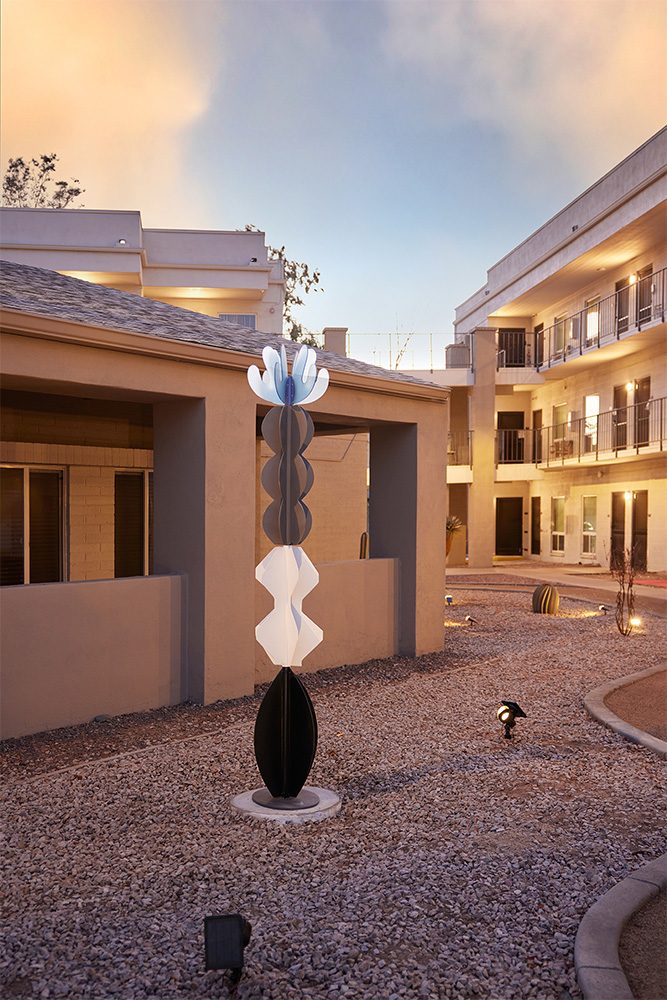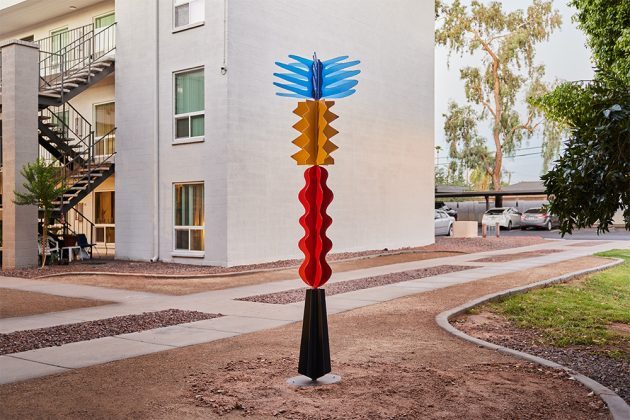The day before Jeff Zischke’s sculptures were installed at Hacienda Del Rio, an affordable housing community in Phoenix, the artist led us through the winding paths of his home studio garden in Scottsdale. Around every corner stood a piece of his world: towering steel forms, hand-welded seed pods, geometric abstractions, and carefully tended bonsai. The air carried the scent of citrus trees and desert blooms—a quiet balance between the organic and the industrial, much like his work itself.
“Creating art is what I do,” Jeff says simply. “It’s my passion. And when people see it, I’m trying to bring smiles to them.”
Watch: A glimpse into Jeff Zischke’s studio and creative process.
A Life in Public Art
Born in New York and raised in Michigan, Jeff Zischke has called Arizona home for more than forty years. He’s created more than twenty large-scale public artworks across the Valley, from Impulsion—a 22-foot stainless-steel horse at Scottsdale’s WestWorld—to Blooming Spire, a 50-foot tower of light and color in Peoria.

Jeff Zischke’s Desert Totem stands within the sculpture garden at Hacienda Del Rio—an interactive work inspired by the rhythms and forms of desert flora.
“I started doing temporary art back then when I was twenty,” he says. “I started with temporary projects for the Montreal and Detroit Jazz Festivals—and I’ve been doing it ever since.”
Zischke’s portfolio stretches far beyond Arizona: works in France, North Carolina, and the Virgin Islands mark a career built on curiosity and collaboration. “A lot of my artwork is community-based,” he explains. “I love when people interact with my sculptures. In fact, the totems I’m doing for this community—people can move them to reorient them. They don’t spin, but you can move them, reshape them. So if it’s possible, I love interactive work.”
The Hacienda Del Rio Commission
For his latest project with ATP.art, Jeff created two Desert Totems—colorful, segmented steel sculptures inspired by palm trees, yucca, and the rhythmic forms of desert flora. Installed within a sculpture garden designed for the residents of Hacienda Del Rio, the works invite interaction and conversation.
“The pieces are derived from plants,” he says. “They’re segmented so they can be rotated and adjusted. They each have their own personality. I think that’s what makes them interesting.”
That interactivity is intentional. “I love when people engage with my sculptures,” Jeff says. “These totems can be moved—reshaped by whoever’s near them. If it’s possible, I always like the idea that people can touch or be part of the work.”
He pauses, smiling. “You know how people say, ‘Don’t touch the art’? I don’t mind. It’s okay with me.”
Walking the Garden
Touring Jeff’s property feels like stepping through chapters of a creative life. The Australian Garden bursts with flowering shrubs and corten-steel sculptures that rise among the plants. Both his Canyons Series and Desert Vertebrae stand nearby—each exploring form through repetition and rhythm, connected through their sculptural language rather than opposed.
In another corner, a bright red dog sculpture catches the light—a prototype for a larger piece soon to be installed in Palm Springs. It’s surrounded by citrus trees, and the quiet hum of bees drifting through the air.
“I hike every single day,” Jeff says as we walk. “The shapes I see in the desert—the creosote, the cactus, the cholla—they all find their way into my work. Even though I take the same trail every day, I see something new every time.”
Inside his greenhouse, rows of boojum and bougainvillea bonsai echo the forms in his sculptures. “It’s all connected,” he says. “There’s not really a difference between art and growing a tomato. You nurture it, shape it, watch it change—it’s the same process.”
Light has always been central to Jeff’s creative process. “I’ve always been into lighting,” he says. “I used to design nightclubs, bars, and restaurants—big, very famous ones in town. I designed custom light fixtures, so I’ve always been into lighting.” Hanging overhead above the bonsai are lamps he’s collected from his travels to India, France, Italy, and Nepal, along with a World War I flashlight found in Serbia. “They light up at night, and it’s very magical,” he adds.
That sensitivity to light carries through to his sculptures. “Many of my pieces are internally lit or I externally light them with projector lights,” Jeff explains. “It’s a big part of how I think about form—how light transforms a surface or brings a shape to life after dark.”
Materials, Light, and Reuse
eff’s studio is equal parts workshop and laboratory. Sheets of steel lean against the walls; cut-off fragments and recycled pieces are stacked neatly for future use. “All my work that I’m doing for public art is site-specific,” he explains. “These were for a park, so I wanted something very natural, like corten. But the totems I’m doing now are for a public space with outdoor venues and people walking around—it’s a condo complex, and more color is necessary for that. So that’s what I did.”
He continues, “It depends on the site. I’m working on a piece for Florida that’s made out of freeform translucent material that still has the organic shape, but they’re going to be internally lit with exterior-rated plastic. So, again, I kind of work with what the client wants and what the site dictates.”
Outside his studio are freshly painted segments of the soon-to-be-completed Desert Totems. Each carries its own unique cut and style. “They’re welded steel,” Jeff says. “I actually cut these out by hand with my plasma cutter, then ground and welded them together. The pipes slide on top of each other so they can be adjusted and reoriented. They stack, and they can rotate like that.”

Built from hand-cut steel and translucent panels, the second Desert Totem brings movement and light into the landscape at Hacienda Del Rio.
We follow him into the welding area—more workshop than gallery. On a nearby table sits the top blue section of the second sculpture, still waiting to be tightened and fastened. “Okay, so these—I welded the steel framework here and then bolted on these 3form pieces,” Jeff explains. “I could laser-cut them, but I actually cut them out with a jigsaw. They’re tensioned with this plate that keeps pressure on it. Yeah—it’s translucent. That’s what’s great about it.”
You can feel his inspiration after walking through the garden and ending in the studio. Each piece reflects Jeff’s fascination with organic rhythm and structure. “They’re derived from plants,” he says. “Palm trees, yucca—the wavy shapes of desert flora. They’re segmented so they can be rotated and adjusted, articulated that way. The colorful one is more vibrant than the other, but they each have their own personality. I think that’s what makes them interesting—that people can engage with them.”
Through another door—his office—sits a table lined with half a dozen miniature Desert Totems. “So these are 3D-printed models that I started playing with,” Jeff says. “It’s interesting to be able to change the shapes and colors. These are small mock-ups I can experiment with. They’re all different, and I can keep changing them. I design them on my computer, then 3D print them in my shop. It’s interesting to pick different colors—it’s a great tool. My process starts with sketches—I draw them out, then do computer drawings, then 3D models, and finally print these small-scale versions. It’s great to see them physically. Then I can scale them up. What a great resource and tool it is.”
Art for Everyone
As an artist whose career spans continents, Zischke is particularly proud of contributing to a public art initiative within an affordable housing community. “My artwork is for the every man, no matter where it is,” he says. “In this environment, I hope people really appreciate it. It’s colorful. It changes as you walk by it, especially with the light and shadow. And it looks indigenous—it belongs here.”
The collaboration with ATP.art came about organically. “They discovered my work online,” Jeff recalls. “They loved what they saw and were looking for something vertical that would work in two pieces. They liked the concept, and we’re working together on it. It’s great. It’s wonderful.”
For Zischke, partnerships like this represent what public art is meant to be: accessible, collaborative, and deeply connected to its surroundings. His sculptures don’t live behind glass—they live in places where people move, gather, and share space. “Everything’s temporal,” he says as we finish the walk back toward his studio. “Nothing lasts forever. That’s what makes creating so special.”
Explore the complete Hacienda Del Rio project, featuring Jeff Zischke’s Desert Totems alongside works by other ATP.art artists, here.
